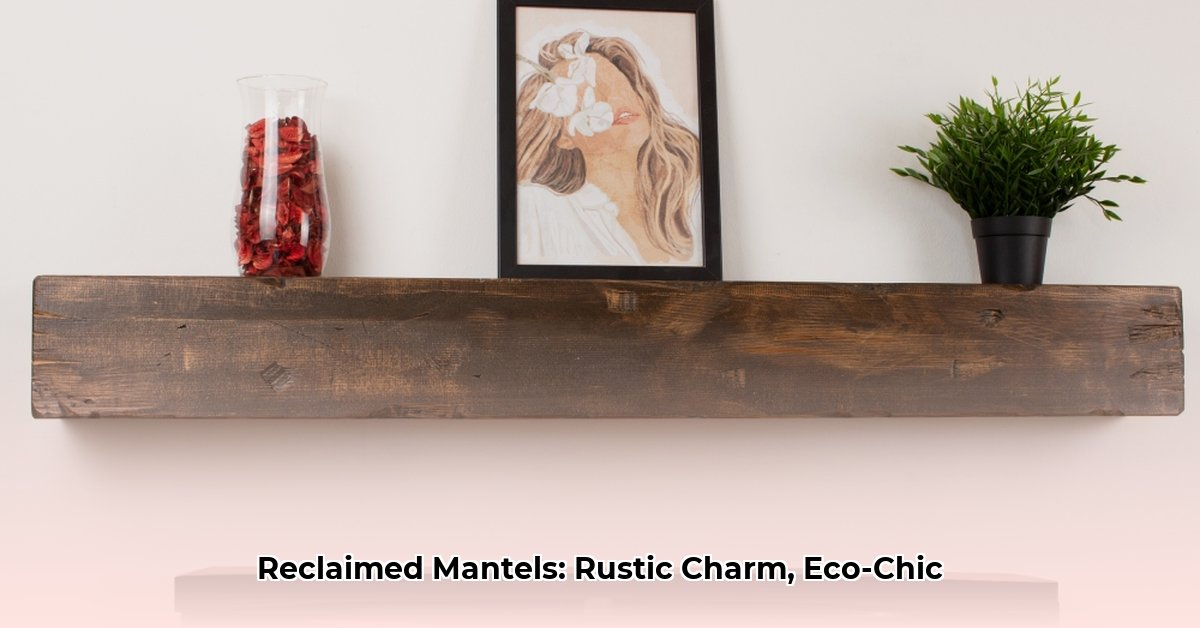“`markdown
Find Your Perfect Reclaimed Mantel: Rustic Styles & Eco-Friendly Options
Want a fireplace mantel with real character, one that’s eco-friendly and totally unique? Reclaimed wood mantels offer a distinctive blend of rustic charm and environmental responsibility. This comprehensive guide explores the various styles of sustainable mantels, ethical sourcing practices, pricing insights, installation options, long-term care tips, and design considerations, empowering you to make an informed decision. Whether you’re seeking a DIY project or prefer professional assistance, discover how to select the perfect reclaimed mantel to elevate your home’s aesthetic and create a cozy, inviting space. For more reclaimed wood ideas, check out this beautiful coffee table.
Reclaimed Mantel: Finding the Perfect Rustic & Eco-Friendly Piece
Choosing a reclaimed wood mantel isn’t just about adding a fireplace surround; it’s about infusing character, history, and sustainability into your home. Salvaged from old barns, factories, and other structures, these unique pieces provide a charm and texture unmatched by mass-produced mantels. With a myriad of options available, how do you navigate the world of reclaimed wood to find the perfect fit for your space while ensuring ethical sourcing and maximizing its design impact? Let’s explore!
Understanding Your Reclaimed Mantel Options: Style and Substance for Home Decor
Understanding the different types of reclaimed mantels is essential for achieving your desired aesthetic. You’ll primarily encounter two styles: solid beam and box mantels. Consider how each complements your existing decor and personal style.
- Solid Beam Mantels: These substantial pieces of wood, often salvaged from a single, large beam, exude rustic presence and historical depth. Their size and weight make them a focal point, perfect for creating a grand, traditional fireplace. Due to their weight, solid beam options often require professional installation. Sizing of solid beam mantels can vary greatly, so be sure to measure your fireplace opening before making a selection.
- Box Mantels: Constructed from smaller pieces of reclaimed wood, box mantels offer a lighter, more manageable, and budget-friendly alternative, providing rustic charm with greater flexibility in size and installation. These are ideal for smaller spaces or modern homes where a lighter touch is preferred. You can customize the dimensions to fit seamlessly into your space.
Beyond construction, different finishes provide further customization and enhance the wood’s natural character.
- Skip-Planed Finish: Retains the wood’s raw texture, highlighting its imperfections and history.
- Hand-Hewn Look: Offers a more refined rustic style, showcasing the craftsmanship of the original beam with axe marks and smoothed surfaces.
- Rough-Sawn Finish: Keeps the wood entirely natural, preserving its original saw marks and rugged appeal. The finish you choose will significantly influence the overall look and feel of your mantel, so consider the existing style of your home and the atmosphere you want to create.
The Source Matters: Ethical and Sustainable Sourcing of Your Mantel
The wood’s origin is crucial aesthetically and ethically. How can you confirm ethical sourcing practices in the reclaimed wood industry and ensure you’re supporting sustainable forestry? Reputable dealers prioritize sustainable practices, ensuring wood comes from responsibly deconstructed structures and not freshly harvested trees. However, consistent sustainability certifications aren’t yet standardized across the industry, emphasizing the need for buyer diligence.
Inquire about the wood’s origin – was it a barn, a factory, or another structure? Ask about the salvaging process and the steps taken to ensure responsible sourcing. Look for certifications like Forest Stewardship Council (FSC) recycled if available. Transparency is key; a reputable dealer will provide detailed information, including photos or documentation of the wood’s provenance. Consider visiting their facility to see their process firsthand.
Decoding the Price: What Influences the Cost of a Reclaimed Mantel?
Pricing for reclaimed mantels varies widely, influenced by wood type, size, condition, finish, sourcing, and the level of craftsmanship involved. Rare wood species or intricate hand-hewn details will command a higher price. Some vendors offer all-inclusive pricing, while others charge separately for finishing, hardware, and shipping – a significant expense, especially for heavier solid beam mantels. Always get a complete, itemized quote upfront to avoid surprises.
Investing in a top-quality mantel from a reputable source represents a worthwhile investment, adding beauty and character to your home for years. Solid beam mantels tend to have more transparency when it comes to pricing, but don’t hesitate to ask for a detailed breakdown of costs for any type of mantel you’re considering.
Installation and Maintenance: Keeping Your Mantel in Top Shape for Interior Design
Installing a reclaimed mantel can often be a DIY project, but the complexity varies. Lighter box mantels are generally easier to install than heavier solid beam counterparts, which sometimes require professional help. Before you begin, assess your skill level and the tools required.
Regardless of the type, proper support and secure fastening are paramount for safety and longevity. Use appropriate hardware for your wall type (drywall, brick, or concrete) and ensure the mantel is securely anchored. Consider hiring a professional if you’re unsure about any aspect of the installation process.
Once installed, regular dusting keeps your reclaimed mantel looking pristine, while light oiling with a natural wood oil helps protect the wood from drying and cracking, extending its life. Avoid harsh chemicals or abrasive cleaners, which can damage the finish. For added protection, consider applying a sealant specifically designed for reclaimed wood.
Solid Beam vs. Box Mantels: A Quick Comparison
| Feature | Solid Beam Mantel | Box Mantel |
|---|---|---|
| Weight | Very heavy | Lighter weight and easier to handle |
| Cost | Typically more expensive | Generally less expensive |
| Installation | Often requires professional installation | Usually manageable as a DIY project |
| Aesthetic | Makes a bold statement; truly rustic and substantial | More versatile; maintains rustic appeal but with more flexibility |
| Maintenance | Requires careful handling due to weight | Easier to clean and maintain |
| Design Impact | Creates a grand, traditional fireplace focal point | Suits smaller spaces or modern homes, offering a lighter touch |
| Customization | Limited customization options | Greater flexibility in size, shape, and finish |
Design Considerations: Integrating Your Reclaimed Mantel into Your Home
Beyond the functional aspects, consider how the mantel will integrate into your overall design scheme. Think about the color palette of your room, the style of your furniture, and the existing architectural features.
- Color: Choose a mantel color that complements your existing decor. Lighter woods can brighten a space, while darker woods add warmth and depth. Consider matching the mantel to other wood elements in the room, such as flooring or furniture.
- Style: Select a mantel style that aligns with your home’s overall aesthetic. A rustic hand-hewn mantel is perfect for a farmhouse or cottage-style home, while a sleek box mantel can complement a modern or contemporary space.
- Scale: Ensure the mantel is appropriately sized for your fireplace and the room. A mantel that is too large can overwhelm the space, while one that is too small can look insignificant.
Conclusion: Making the Right Choice for Fireplace Decor
Choosing a reclaimed wood mantel is a journey of discovery – a quest for the perfect blend of style, sustainability, and lasting quality. By understanding the different types, considering ethical sourcing, carefully weighing pricing and installation factors, and paying attention to design considerations, you can confidently select a mantel that enhances your home’s aesthetic and reflects your values. Remember to prioritize transparency and thorough research when selecting a vendor to find a mantel that you’ll enjoy for years to come.
How to Choose the Right Reclaimed Wood Mantel Finish for My Fireplace
Key Takeaways:
- Reclaimed wood mantels exude unique character and eco-friendly appeal.
- Choosing the right finish protects from heat, moisture, and wear while enhancing its natural beauty.
- Wood type, aesthetic preference, application ease, maintenance requirements, and environmental impact all influence your choice.
- Consider the long-term performance and the specific needs of reclaimed wood when selecting a finish.
- Reputable sourcing ensures sustainability and quality of reclaimed material, further adding to the value of your investment.
Types of Reclaimed Wood and Finishes for Fireplace Mantels
Choosing a reclaimed wood mantel is exciting! But how do I choose the right reclaimed wood mantel finish for my fireplace, maximizing its protection and visual appeal? Consider the wood type. Hardwoods, like oak, are naturally durable and can handle a variety of finishes; softer woods, like pine, need more protection. What finish options will best enhance my reclaimed wood mantel while ensuring its longevity in a fireplace environment?
Here are some popular finish options:
- Natural Oils (Tung, Danish): These enhance the wood’s grain, offering a low-VOC (volatile organic compounds), natural look, but they provide less protection against heat and moisture and require more frequent maintenance. Ideal for mantels placed further away from the firebox.
- Polyurethane (Water-based/Oil-based): Polyurethane provides a durable, protective barrier against heat, moisture, and scratches. Water-based options are lower in VOCs and dry faster, making them a more environmentally friendly choice. Oil-based polyurethanes offer slightly better protection and a warmer tone, but they have higher VOCs. This is generally a good choice for most reclaimed wood mantels.
- **Heat-Resistant
- Glass Backsplash: Ideas For a Stylish Kitchen Update - December 2, 2025
- Glass On Tile: A Stylish Kitchen Backsplash Option - December 1, 2025
- Glass Tiles for Kitchen: Style and Durability Tips - November 30, 2025










